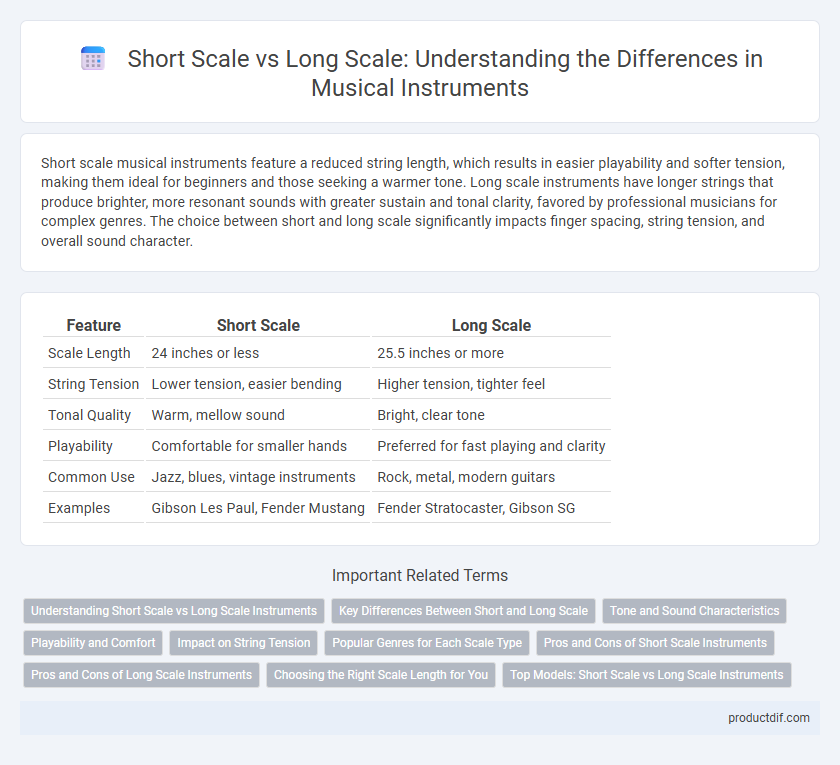Short scale musical instruments feature a reduced string length, which results in easier playability and softer tension, making them ideal for beginners and those seeking a warmer tone. Long scale instruments have longer strings that produce brighter, more resonant sounds with greater sustain and tonal clarity, favored by professional musicians for complex genres. The choice between short and long scale significantly impacts finger spacing, string tension, and overall sound character.
Table of Comparison
| Feature | Short Scale | Long Scale |
|---|---|---|
| Scale Length | 24 inches or less | 25.5 inches or more |
| String Tension | Lower tension, easier bending | Higher tension, tighter feel |
| Tonal Quality | Warm, mellow sound | Bright, clear tone |
| Playability | Comfortable for smaller hands | Preferred for fast playing and clarity |
| Common Use | Jazz, blues, vintage instruments | Rock, metal, modern guitars |
| Examples | Gibson Les Paul, Fender Mustang | Fender Stratocaster, Gibson SG |
Understanding Short Scale vs Long Scale Instruments
Short scale instruments typically feature a scale length under 25 inches, offering easier playability and a warmer tone, ideal for beginners and players with smaller hands. Long scale instruments, usually over 25 inches in scale length, provide greater string tension, producing a brighter sound with enhanced sustain and clearer intonation. Choosing between short scale and long scale depends on desired tonal characteristics, playability, and musical style preferences.
Key Differences Between Short and Long Scale
Short scale instruments typically have a scale length ranging from 24 inches or less, resulting in a warmer tone and easier playability due to lower string tension. Long scale instruments, often measuring 25.5 inches or more, produce a brighter, more defined sound with increased string tension, which can enhance sustain and clarity. The choice between short and long scale significantly impacts string tension, tonal characteristics, and overall comfort for players with varying hand sizes.
Tone and Sound Characteristics
Short scale instruments produce warmer, mellower tones with enhanced midrange frequencies, making them ideal for genres requiring smooth, rounded sounds. Long scale instruments deliver brighter, sharper tones with more sustain and clarity, suited for styles that emphasize articulate, punchy sound. The scale length significantly impacts string tension, which in turn affects the resonance and harmonic complexity of the musical instrument.
Playability and Comfort
Short scale musical instruments, typically ranging from 24 to 25 inches, offer enhanced playability and comfort due to reduced string tension and closer fret spacing, making them ideal for players with smaller hands or those seeking easier finger stretches. Long scale instruments, usually 25.5 inches or longer, provide a brighter tone and greater string tension but may cause increased finger fatigue and less ergonomic comfort during extended play. Choosing between short and long scale depends on balancing tonal preference with personal comfort and technical ease.
Impact on String Tension
Short scale guitars typically have a scale length of around 24 inches, resulting in lower string tension that makes bending strings easier and favors a warmer tone. Long scale guitars, often measuring 25.5 inches or more, create higher string tension that provides greater sustain, clarity, and a brighter sound. The difference in tension directly affects playability and tonal characteristics, influencing musicians' choice based on style and technique.
Popular Genres for Each Scale Type
Short scale instruments are favored in genres like blues, jazz, and indie rock due to their easier playability and warmer tone. Long scale instruments dominate in genres such as metal, hard rock, and funk, providing tighter string tension and clearer articulation. Musicians choose scale length to match genre-specific tonal preferences and playing techniques.
Pros and Cons of Short Scale Instruments
Short scale instruments, typically featuring a scale length under 32 inches, offer enhanced playability and comfort, making them ideal for beginners and players with smaller hands. Their compact design often results in a warmer, mellower tone but may sacrifice some sustain and string tension compared to long scale instruments. Despite these advantages, short scale instruments can have limitations in clarity and projection, which may affect performance in genres requiring bright, punchy sounds.
Pros and Cons of Long Scale Instruments
Long scale musical instruments offer enhanced string tension, providing a clearer, more defined tone and better sustain, which suits genres requiring precise articulation. Their extended neck length increases fret spacing, benefiting players with larger hands or those seeking improved intonation accuracy. However, the longer scale can challenge beginners due to increased finger stretch and may cause reduced playability and comfort for musicians preferring faster, more agile finger movements.
Choosing the Right Scale Length for You
Choosing the right scale length for your musical instrument depends on finger comfort, playing style, and tonal preference. Short scale instruments, typically around 24 inches, offer easier fretboard navigation and a warmer, mellower tone, ideal for beginners or players with smaller hands. Long scale instruments, usually 25.5 inches or longer, provide increased string tension, brighter sound, and greater sustain, preferred by musicians seeking enhanced clarity and dynamic range.
Top Models: Short Scale vs Long Scale Instruments
Top models of short scale instruments, such as the Fender Mustang Bass and Gibson Les Paul Junior, offer enhanced playability and a warmer tone ideal for genres like blues and jazz. Long scale instruments like the Fender Precision Bass and Gibson SG provide stronger string tension, clearer note definition, and are preferred for rock and metal due to their extended range and sustain. Choosing between short scale and long scale depends on the player's style, hand size, and tonal preferences in professional music settings.
Short scale vs Long scale Infographic

 productdif.com
productdif.com